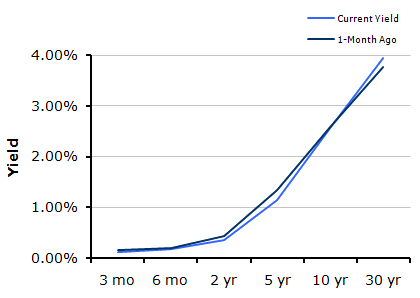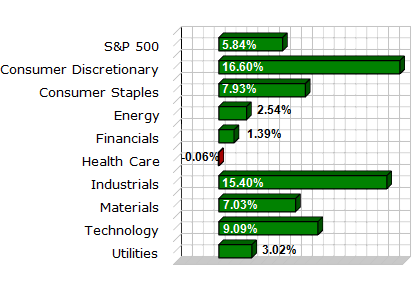
Market Commentary by Scott J. Brown, Ph.D., Chief Economist

The economic data was mixed, but generally soft. Industrial production fell 0.2% in September. Manufacturing output fell 0.2%, with and without autos. Building permits fell in September, reflecting the usual volatility in the multi-family sector (single-family permits edged up 0.5%), while housing starts (which are choppy and subject to large revisions) rose more than expected. The Fed’s Beige Book noted that “on balance, national economic activity continued to rise, albeit at a modest pace, during the reporting period from September to early October.” Prices of final goods and services were “mostly stable as higher costs were not passed on to consumers.” Hiring remained “limited,” with “many firms reluctant to add to permanent payrolls given economic softness.”
Earnings reports were mixed, but mostly positive relative to expectations, fueling the stock market action. The bond market seemed to mark time, waiting for the November 3 Fed policy decision. The currency market saw brief short-covering in the dollar following China’s surprise announcement of an interest rate hike.
Next week, earnings reports will continue to drive the stock market. There are a number of potentially market-moving economic data releases, but Friday’s GDP estimate should carry the most weight. There’s always a lot of uncertainty in the advance GDP estimate. The government will have to make assumptions about foreign trade, inventories, and a few other components in September. Consumer spending appears to have risen moderately in Q310 and business fixed investment is likely to remain positive. Net exports may subtract somewhat from overall growth, but inventories are likely to add to the headline figure. Remember, the GDP figures will be revised on November 23rd and again on December 22nd.
Indices
| Last | Last Week | YTD return % | |
| DJIA | 11146.57 | 11094.57 | 6.89% |
| NASDAQ | 2459.67 | 2435.38 | 8.40% |
| S&P 500 | 1180.26 | 1173.81 | 5.84% |
| MSCI EAFE | 1632.23 | 1641.29 | 3.26% |
| Russell 2000 | 698.12 | 704.69 | 11.63% |
Consumer Money Rates
| Last | 1-year ago | |
| Prime Rate | 3.25 | 3.25 |
| Fed Funds | 0.25 | 0.25 |
| 30-year mortgage | 4.23 | 5.14 |
Currencies
| Last | 1-year ago | |
| Dollars per British Pound | 1.572 | 1.660 |
| Dollars per Euro | 1.394 | 1.501 |
| Japanese Yen per Dollar | 81.280 | 91.000 |
| Canadian Dollars per Dollar | 1.027 | 1.040 |
| Mexican Peso per Dollar | 12.423 | 12.910 |
Commodities
| Last | 1-year ago | |
| Crude Oil | 80.06 | 81.04 |
| Gold | 1324.35 | 1062.20 |
Bond Rates
| Last | 1-month ago | |
| 2-year treasury | 0.35 | 0.43 |
| 10-year treasury | 2.56 | 2.58 |
| 10-year municipal (TEY) | 3.94 | 3.94 |
Treasury Yield Curve – 10/22/2010

S&P Sector Performance (YTD) – 10/22/2010

Economic Calendar
| October 25th | — | Existing Home Sales (September) |
| October 26th | — | S&P/Case-Shiller Home Price Index (August) Consumer Confidence (October) |
| October 27th | — | Durable Goods Orders (September) New Home Sales (September) |
| October 28th | — | Jobless Claims (week ending October 23rd) |
| October 29th | — | Real GDP (3Q10, Advance estimate) Chicago PM Index (October) Consumer Sentiment (October) |
| November 1st | — | Personal Income and Spending(September) ISM Manufacturing Index (October) |
| November 2nd | — | Election Day |
| November 2nd/3rd | — | FOMC Meeting |
| November 5th | — | Employment Report (October) |
| November 11th | — | Veterans Day (bond market closed) |
Important Disclosures
Past performance is not a guarantee of future results. There are special risks involved with global investing related to market and currency fluctuations, economic and political instability, and different financial accounting standards. The above material has been obtained from sources considered reliable, but we do not guarantee that it is accurate or complete. There is no assurance that any trends mentioned will continue in the future. While interest on municipal bonds is generally exempt from federal income tax, it may be subject to the federal alternative minimum tax, state or local taxes. In addition, certain municipal bonds (such as Build America Bonds) are issued without a federal tax exemption, which subjects the related interest income to federal income tax. Investing involves risk and investors may incur a profit or a loss.
US government bonds and treasury bills are guaranteed by the US government and, if held to maturity, offer a fixed rate of return and guaranteed principal value. US government bonds are issued and guaranteed as to the timely payment of principal and interest by the federal government. Treasury bills are certificates reflecting short-term (less than one year) obligations of the US government.
Commodities trading is generally considered speculative because of the significant potential for investment loss. Markets for commodities are likely to be volatile and there may be sharp price fluctuations even during periods when prices overall are rising. Specific sector investing can be subject to different and greater risks than more diversified investments.
Tax Equiv Muni yields (TEY) assume a 35% tax rate on triple-A rated, tax-exempt insured revenue bonds.
![]() Material prepared by Raymond James for use by its financial advisors.
Material prepared by Raymond James for use by its financial advisors.
The information contained herein has been obtained from sources considered reliable, but we do not guarantee that the foregoing material is accurate or complete. Data source: Bloomberg, as of close of business October 21st, 2010.
©2010 Raymond James Financial Services, Inc. member FINRA / SIPC.


